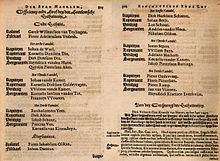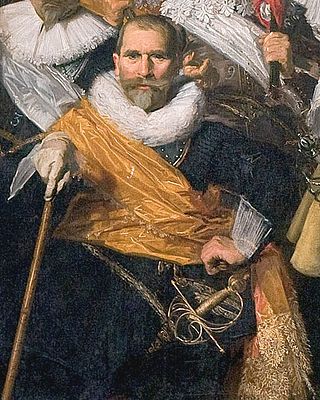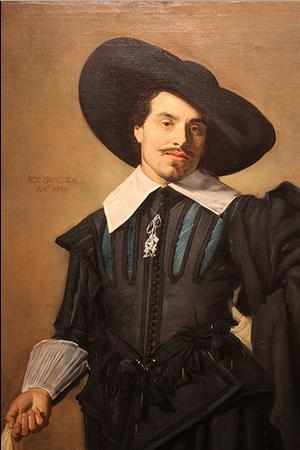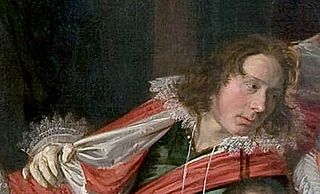
The Haarlem schutterij refers to a collective name for the voluntary civic guard of Haarlem, from medieval times up to the Batavian Revolution in 1794, when the guilds of Haarlem were disbanded.

The Haarlem schutterij refers to a collective name for the voluntary civic guard of Haarlem, from medieval times up to the Batavian Revolution in 1794, when the guilds of Haarlem were disbanded.

During the Hook and Cod wars in 1402, Haarlem formed a hand bow schutterij under the patronage of St. George of 120 citizen volunteers to support the local court of Justice. The guild-like group had its own altar in the St. Bavochurch and they even had processions through town on the name day of their saint. The town suffered from uprisings in 1417 and 1422. After another uprising in 1425, a "New" schutterij was formed to educate young men in the use of the crossbow and they defended the city in 1426 against Jacoba of Beieren. The "New" crossbow schutterij had a new meeting hall built for them near the Spaarne river, and in 1468 a separate schutterij was formed under the patronage of St. Sebastian for hand bowmen. Around 1500 Haarlem had three schutterij groups, two (old and new) under the patronage of St. George (St. Joris), and one under the patronage of St. Sebastian, all with their own altars in church.
In 1520 the Haarlem schutterij was reorganized; the two groups under St. Joris were merged into one group for crossbowmen and a new group was formed under the patron saint St. Hadrian (St. Adrian), called Cloveniers. Though the St. Sebastian group was also still active, by 1560 all were using muskets, and the town even owned some cannons, for which special "kannoniers" were trained. They still kept up their social activities in church, though the Protestant reformation began to cause various problems with their political support for the court of Justice.
The most heroic deeds of the Haarlem schutterij occurred during the Spanish siege of Haarlem, which ended in victory for the Spanish. After the changeover to the Dutch Republic in 1581, the Haarlem schutters, or shooters, were reorganized into two groups, one keeping the name St. Joris and also called the "Oude schuts", and the other keeping the name Cloveniers, and receiving a new building in their old location in the Gasthuisstraat in 1612, leading them to earn the nickname "Nieuwe schuts". The activities of both groups around their church altars, including the yearly processions, were discontinued. Today many of the shooters have been immortalized in the group portraits by Frans Hals and other portrait painters on show at the Frans Hals museum.
The split into two groups was more for convenience sake than for tradition, as the two groups were split geographically into a group north of the Bavochurch (officially renamed Grote Kerk) and a group south of the Bavochurch.

The term "Cloveniers", or Cluveniers, just means "musket bearers". The group name changed over time according to the fashions and locations of the guild. Until the siege of Haarlem they were under the patronage of the Saint Adrian, but were most often referred to as the "Jonge schuts", or "New shoots", since they were formed in 1520. After the siege, since all "Catholic" saints were banned, and they had a new meeting hall built in 1612, they became known as the "Nieuwe schuts", or "New shoots". That meeting hall in the Gasthuisstraat is still called the "Doelen" building after them. Today it is a study hall and part of the Haarlem Public Library. [1] The paintings by Hals and others hung in the main hall of the building in the Gasthuisstraat. Today almost all of the schutterstukken that once hung here have been transferred to the Frans Hals Museum; the 1612 painting by Cornelis Engelsz is in the Musée des Beaux-Arts de Strasbourg, France.

In 1577, the city council refurbished the main buildings of the old St. Michiels cloister to house the schutterij called the "Oude schuts", whose hall had been burned in the fire of 1572. Though they officially no longer had a patron saint, they were still referred to as the St. Jorisdoelen, or St. George militia target field. The former garden was converted to include two shooting lanes, and a new meeting hall was built in 1592. [2] Today the location houses a shop, restaurant, and a hofje surrounds the garden called the Proveniershuis.

Cornelis Corneliszoon van Haarlem was a Dutch Golden Age painter and draughtsman, one of the leading Northern Mannerist artists in the Netherlands, and an important forerunner of Frans Hals as a portraitist.

Schutterij refers to a voluntary city guard or citizen militia in the medieval and early modern Netherlands, intended to protect the town or city from attack and act in case of revolt or fire. Their training grounds were often on open spaces within the city, near the city walls, but, when the weather did not allow, inside a church. They are mostly grouped according to their district and to the weapon that they used: bow, crossbow or gun. Together, its members are called a Schuttersgilde, which could be roughly translated as a "shooter's guild". It is now a title applied to ceremonial shooting clubs and to the country's Olympic rifle team.

The Proveniershuis is a hofje and former schutterij on the Grote Houtstraat in Haarlem, Netherlands.

The Haarlem Guild of Saint Luke was first a Christian, and later a city Guild for various trades falling under the patron saints Luke the Evangelist and Saint Eligius.

Theodorus Schrevelius was a Dutch Golden Age writer and poet.

The Banquet of the Officers of the St George Militia Company in 1616 refers to the first of several large schutterstukken painted by the Dutch painter Frans Hals for the St. George civic guard of Haarlem, and today is considered one of the main attractions of the Frans Hals Museum, Haarlem.

Banquet of the officers of the Calivermen Civic Guard, Haarlem formerly known as The Banquet of the Officers of the St Adrian Militia Company in 1627, refers to a schutterstuk painted by Frans Hals, in 1627, for the St. Adrian civic guard of Haarlem. Today it is considered one of the main attractions of the Frans Hals Museum, in Haarlem.

The Officers of the St Adrian Militia Company in 1633 refers to the second schutterstuk painted by Frans Hals for the Cluveniers, St. Adrian, or St. Hadrian civic guard of Haarlem, in 1633, and today considered one of the main attractions of the Frans Hals Museum there.

The Officers of the St Adrian Militia Company in 1630 refers to the schutterstuk painted by Hendrik Gerritsz Pot for the Cluveniers, St. Adrian, or St. Hadrian civic guard of Haarlem, and today is considered one of the main attractions of the Frans Hals Museum there.

The Banquet of the Officers of the St George Militia Company is an oil-on-canvas painting by the Dutch artist Frans Hals, painted from 1626 - 1627, during the Dutch Golden Age. Today, the piece is considered one of the main attractions of the Frans Hals Museum.

The Officers of the St George Militia Company in 1639 refers to the last and largest schuttersstuk painted by Frans Hals for the St. George civic guard of Haarlem, and today is considered one of the main attractions of the Frans Hals Museum in Haarlem.

Johan Claesz van Loo, was a Dutch brewer, owning De Drie Leliën in Haarlem, best known today for his portrait painted by Frans Hals.

Cornelis Coning or Koning, was an engraver and mayor of Haarlem.

Florens Pietersz van der Houff, was a magistrate and mayor of Haarlem who became a member of the Admiralty of Amsterdam during the years 1655 - 1657.

Jacob Cornelisz Schout, was a Dutch Golden Age member of the Haarlem schutterij.

Cornelis Jacobsz Schout, was a Dutch Golden Age member of the Haarlem schutterij.

Gerrit Cornelisz. Vlasman, was a Dutch Golden Age brewer and member of the Haarlem schutterij.

Johan Damius, was a Dutch Golden Age member of the Haarlem schutterij.

The St Adrian Civic Guard is a 1612 militia group portrait painting by the Dutch artist Cornelis Engelsz. It is now in the Musée des Beaux-Arts of Strasbourg, France. Its inventory number is 364.
The painting was bought from Charles Sedelmeyer in 1895 by the director of the Strasbourg museum, Wilhelm von Bode, and entered the collections two years later. As of 2014, it was the only Dutch painting of that kind in a French museum.